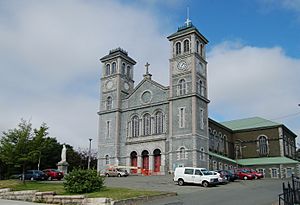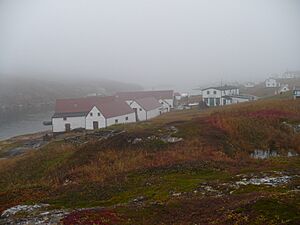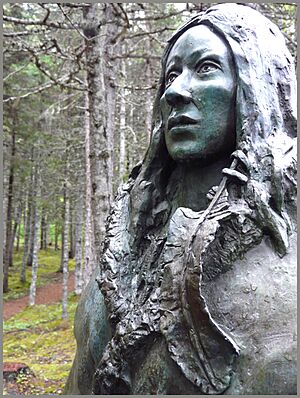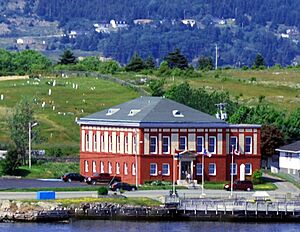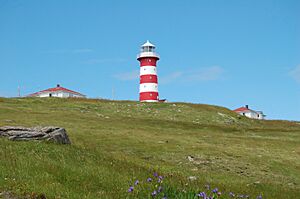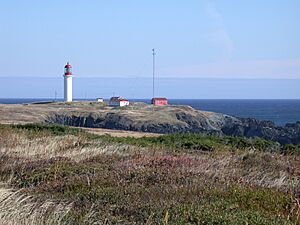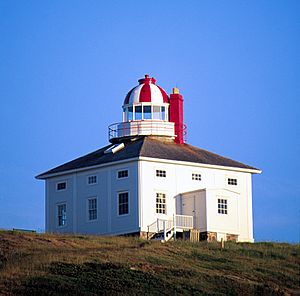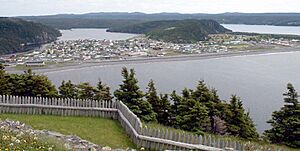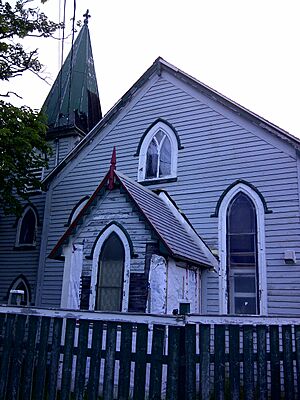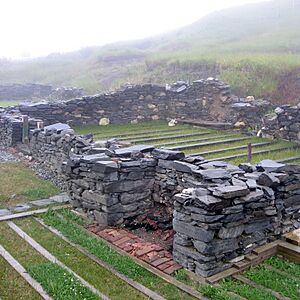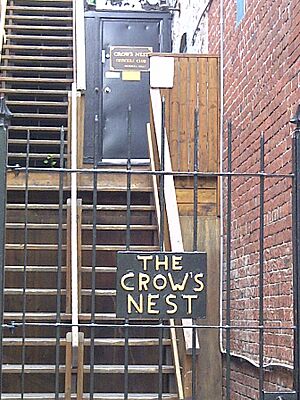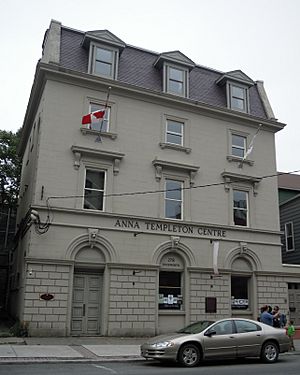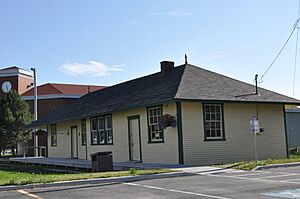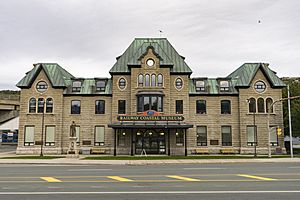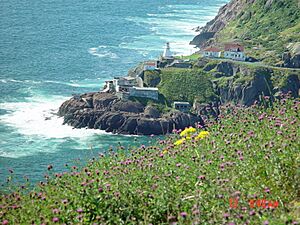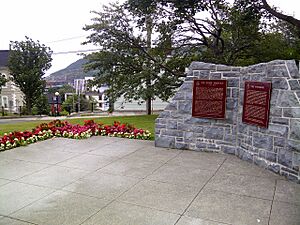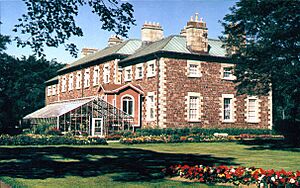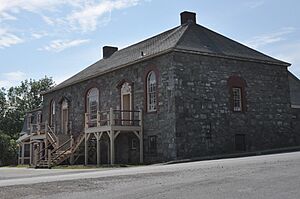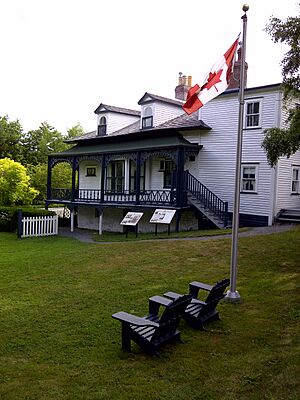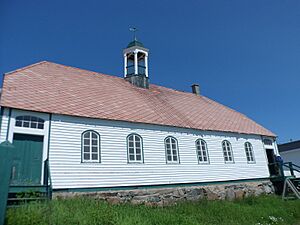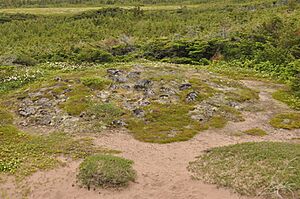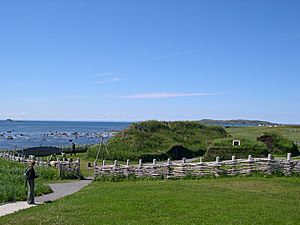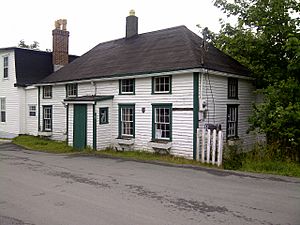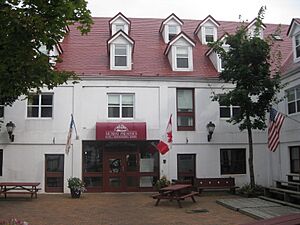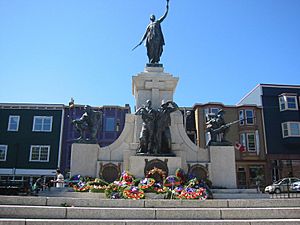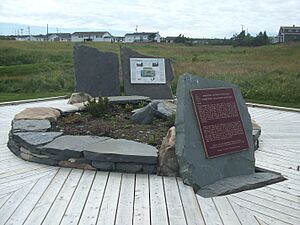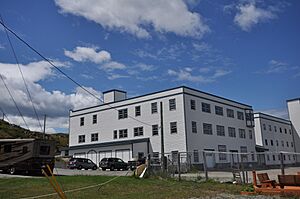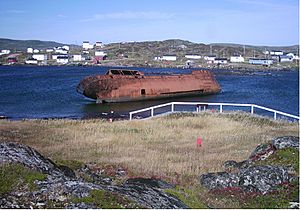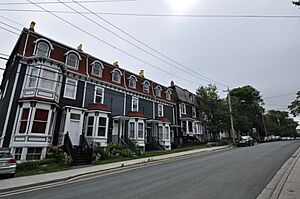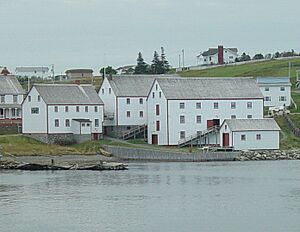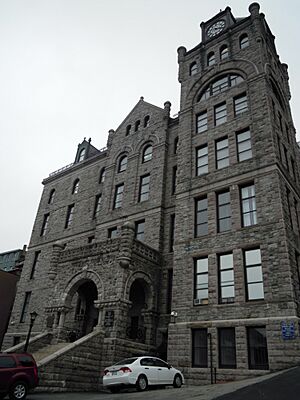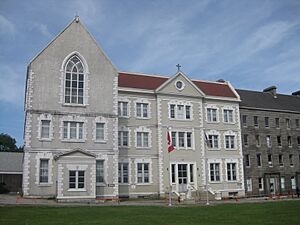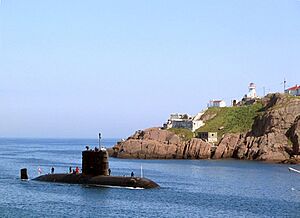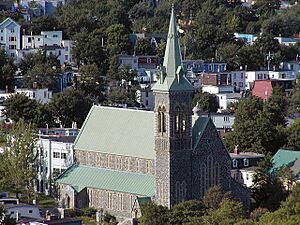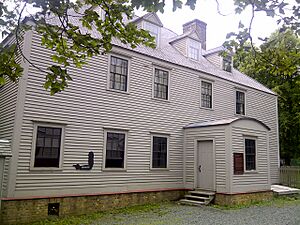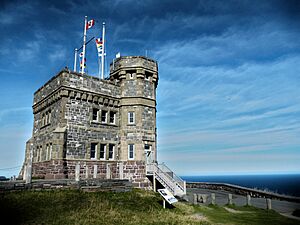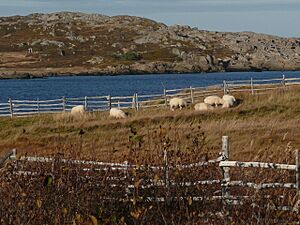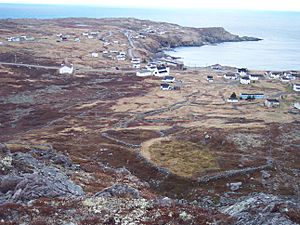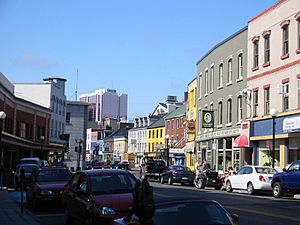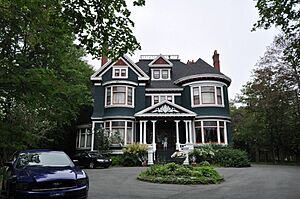List of National Historic Sites of Canada in Newfoundland and Labrador facts for kids
Canada is full of amazing places that tell stories about its past! These special spots are called National Historic Sites. In Newfoundland and Labrador, there are 47 of these important places. They help us learn about the history of this province.
Some of these sites are looked after by Parks Canada, which is like a national park service. You'll see a little beaver icon next to their names in other places, but here we'll just tell you if Parks Canada manages them. Most other sites are owned by local towns, churches, or even families, and they might not always be open to visitors.
The very first National Historic Sites in Newfoundland and Labrador were named in 1951. These included Fort Amherst, Fort Townshend, and Signal Hill.
Did you know that one National Historic Site connected to Newfoundland and Labrador is actually in France? It's called the Beaumont-Hamel Newfoundland Memorial. It remembers the brave soldiers from Newfoundland who were lost during World War I.
Besides sites, Canada also recognizes important historical events and people. These are often marked with special plaques, just like the sites. This list uses the official names given by the Historic Sites and Monuments Board of Canada.
Contents
- National Historic Sites in Newfoundland and Labrador
- Basilica of St. John the Baptist
- Battle Harbour Historic District
- Boyd's Cove Beothuk
- Cable Building
- Cape Pine Lighthouse
- Cape Race Lighthouse
- Cape Spear Lighthouse
- Castle Hill
- Christ Church / Quidi Vidi Church
- Colony of Avalon
- Crow's Nest Officers' Club
- Fleur de Lys Soapstone Quarries
- Former Bank of British North America
- Former Carbonear Railway Station
- Former Newfoundland Railway Headquarters
- Fort Amherst
- Fort Townshend
- Fort William
- Government House
- Harbour Grace Court House
- Hawthorne Cottage
- Hebron Mission
- Hopedale Mission
- Indian Point
- Kitjigattalik - Ramah Chert Quarries
- L'Anse Amour
- L'Anse aux Meadows
- Mallard Cottage
- Murray Premises
- Newfoundland National War Memorial
- Okak
- Port au Choix
- Port Union Historic District
- Red Bay
- Rennie's Mill Road Historic District
- Ryan Premises
- St. John the Baptist Anglican Cathedral
- St. John's Court House
- St. John's Ecclesiastical District
- St. John's WWII Coastal Defences (Atlantic Bulwark)
- St. Patrick's Roman Catholic Church
- St. Thomas Rectory / Commissariat House and Garden
- Signal Hill
- Tilting
- Walled Landscape of Grates Cove
- Water Street Historic District
- Winterholme
- See also
National Historic Sites in Newfoundland and Labrador
Basilica of St. John the Baptist
This large stone church was finished in 1855 in St. John's. It's built in a style called Lombard Romanesque Revival. This church has played a huge role in the religious, political, and social life of Newfoundland and Labrador for many years.
Battle Harbour Historic District
Established in the 1770s, Battle Harbour is a great example of a traditional "outport" fishing community. An outport is a small, isolated coastal settlement. The buildings and spaces here show what fishing villages were like in the 1800s and early 1900s.
Boyd's Cove Beothuk
This is a very important archaeological site near Boyd's Cove. People lived here around 3000 BCE (that's over 5,000 years ago!). Discoveries here have taught us a lot about the early history and eventual disappearance of the Beothuk people, who were the original inhabitants of Newfoundland.
Cable Building
Completed in 1913 in Bay Roberts, this building was super important for communication. In the early 1900s, Newfoundland was a major hub for sending messages across the Atlantic Ocean. This building was the main relay station for the Western Union Telegraph Company's transatlantic cables, connecting North America and Europe.
Cape Pine Lighthouse
This lighthouse was finished in 1851 at Cape Pine. It was one of the first lighthouses in Newfoundland made from prefabricated iron. This design made it easier to build in tough, remote locations. It was the first light built on the dangerous south coast of the Avalon Peninsula to help ships navigate the Cabot Strait.
Cape Race Lighthouse
Finished in 1907, the Cape Race Lighthouse at Cape Race was one of the most important lighthouses on the southern shore of the Avalon Peninsula. It had one of the most powerful lights in the world at the time, guiding ships through dangerous waters.
Cape Spear Lighthouse
This lighthouse, completed in 1835, is the oldest surviving lighthouse in Newfoundland. It stands on Cape Spear, the easternmost point in North America. The Newfoundland Colony built it to guide ships into St. John's harbour. This site is managed by Parks Canada.
Castle Hill
Established in 1692, Castle Hill in Placentia holds the remains of old French and British forts. These forts were very important for defending the area and for the larger military plans of France and Britain in Atlantic Canada. This site is managed by Parks Canada.
Christ Church / Quidi Vidi Church
This simple wooden church, completed in 1842, is located on a steep hill overlooking the harbour of the old village of Quidi Vidi in St. John's. It's a great example of the disappearing architecture of 19th-century Newfoundland outports.
Colony of Avalon
Established in 1621 in Ferryland, the Colony of Avalon was an important fishing and trading post in the 1600s. Even though it was attacked and abandoned in 1696, it is the best-preserved early English settlement in Canada.
Crow's Nest Officers' Club
Opened in 1942 in St. John's, this club was a special place for naval officers during the Second World War. Officers from Allied navies would decorate sections of the walls to remember their ships. The club, with all its military items and artwork, is a memorial to the naval efforts during the war.
Fleur de Lys Soapstone Quarries
Around 400 CE, these quarries in Fleur de Lys were a key source of Soapstone. This material was very important for many Indigenous groups in Newfoundland, who used it to make bowls and oil lamps. This archaeological site shows how the Dorset culture extracted resources.
Former Bank of British North America
This three-and-a-half-storey brick building in St. John's was completed in 1850. It has a mansard roof and Italianate features. From 1849 to 1985, it housed many of Newfoundland's major banks, showing the history of banking in the province.
Former Carbonear Railway Station
Completed in 1918 in Carbonear, this one-storey wooden building with a hip roof was a typical railway station. It represents the many stations along the Newfoundland Railway and the common style of rural railway stations across Canada in the early 1900s.
Former Newfoundland Railway Headquarters
This two-and-a-half-storey stone building in St. John's was built in 1903. It has design elements from both the Second Empire and Château styles. It remembers the important role the Newfoundland Railway played in the social, economic, and political history of the province. Today, it's the Railway Coastal Museum.
Fort Amherst
Established in 1777 in St. John's, this was the site of a British fort built to protect the entrance to St. John's harbour. There are no visible remains of the fort today. It was named after William Amherst, who took St. John's back from the French in 1762.
Fort Townshend
This archaeological site in St. John's is where a British fort once stood. It was the main base for the Newfoundland military from 1779 until 1871. Today, the site is home to The Rooms, a cultural facility.
Fort William
Established in 1697 in St. John's, this was the first official military base for the British in Newfoundland. The fort was attacked three times by the French. It was later replaced by Fort Townshend in the 1770s and torn down in 1881.
Government House
Completed in 1831 in St. John's, this Palladian-style mansion was built for Thomas John Cochrane, the first civilian governor of the Newfoundland Colony. Its construction marked a big change for the colony, from military rule to civilian government. It has been the official home of Newfoundland's governors and lieutenant governors ever since.
Harbour Grace Court House
This two-storey stone building in Harbour Grace was completed in 1830. It has a unique split staircase at the front. It is the oldest public building still standing in the province.
Hawthorne Cottage
Completed around 1830 in Brigus, this charming Picturesque cottage has a wrap-around porch. It was once the home of Robert Bartlett, a famous Arctic explorer. This site is managed by Parks Canada.
Hebron Mission
Established in 1829 in Hebron, this group of connected buildings includes a church, mission house, and store. They are built in a German-influenced style. This was a Moravian center that provided religious teaching, trade, and medical care to the local Inuit people.
Hopedale Mission
Established in 1782 in Hopedale, this complex of large wooden buildings was built by the Moravian Church. It tells the story of how the Labrador Inuit and missionaries interacted, and it's a great example of Moravian Mission architecture in Labrador. This site is managed by Parks Canada.
Indian Point
Located at Beothuk Lake, this is a well-documented Beothuk site. It was a winter camp where the Beothuk people lived in strong, multi-sided homes called mamateeks and hunted caribou. It was used for many generations before being abandoned around 1820.
Kitjigattalik - Ramah Chert Quarries
Active from 3000 BCE to 1400 AD, these quarries in Torngat Mountains National Park were a source of unique chert stone. This stone was traded widely across eastern North America. It has been linked to ancient burial sites and belief systems, and it was the basis for long-distance trade between eastern Canada and New England. This site is managed by Parks Canada.
L'Anse Amour
Dating back to around 6100 BCE, L'Anse Amour is one of the largest and longest-used Indigenous living sites in Labrador. It also holds the earliest known funeral monument in the New World (North and South America).
L'Anse aux Meadows
Around 1000 CE, L'Anse aux Meadows near St. Anthony became the first known settlement established by Vikings in North America. This site has the earliest proof that Europeans were in Canada. It's also a World Heritage Site, recognized globally for its importance. This site is managed by Parks Canada.
Mallard Cottage
Built around 1820 in St. John's, this wooden house with a hip roof and central chimney is a typical example of the simple homes built by Irish immigrants in the early 1800s.
Murray Premises
This group of three former warehouses in St. John's was completed in 1849. It reminds us of the many offices and warehouses that once lined St. John's harbour. It also celebrates the city's long history of trade by sea.
Newfoundland National War Memorial
Dedicated in 1924 in St. John's, this impressive memorial honors Newfoundland's sacrifices during World War I and other conflicts. It's also the spot where Sir Humphrey Gilbert claimed Newfoundland for England in 1583.
Okak
First settled around 5550 BCE, Okak in Labrador has sixty archaeological sites. These sites show how people lived from the ancient Maritime Archaic period all the way to the Labrador Inuit. It was also the location of the second oldest Moravian mission in Labrador, founded in 1776.
Port au Choix
Port au Choix is home to two incredibly rare and rich pre-contact archaeological sites. One is an ancient Maritime Archaic cemetery, and the other is a Paleo-Eskimo living site. These sites offer unique insights into early Indigenous cultures. This site is managed by Parks Canada.
Port Union Historic District
Established in 1916 in Trinity Bay North, Port Union is the only town in Canada founded by a union. It was built by the Fishermen's Protective Union and became known for its success in business, even with tough competition.
Red Bay
Around 1550, Red Bay became one of the largest whaling ports used by Basque whaling expeditions from France and Spain. It's a World Heritage Site because it has well-preserved evidence of 16th-century whaling activities, both on land and underwater in the harbour. This site is managed by Parks Canada.
Rennie's Mill Road Historic District
Established in 1846 in St. John's, this area was originally a suburb with large wooden houses. Most of these homes were built in the late 1800s and early 1900s. It's a very consistent group of homes belonging to upper-middle-class families, many of whom were important people in Newfoundland at the time.
Ryan Premises
Established in 1857 in Bonavista, the Ryan Premises is a "cultural landscape." This means it includes homes and business buildings that show what a 19th-century Newfoundland "mercantile outport" was like. A mercantile outport was a fishing village focused on trade. These buildings are still in their original spot by the sea. This site is managed by Parks Canada.
St. John the Baptist Anglican Cathedral
Completed in 1850 in St. John's, this magnificent stone cathedral was designed by George Gilbert Scott. It's for Canada's oldest Anglican parish. It's a nationally important example of Gothic Revival architecture, a style that brought back medieval church designs.
St. John's Court House
Completed in 1904 in St. John's, this granite and sandstone Romanesque Revival-style courthouse is the most detailed courthouse in the province. It represents the justice system in Newfoundland.
St. John's Ecclesiastical District
This district in St. John's includes buildings and landscapes connected to the Roman Catholic, Anglican, United (formerly Methodist), and Presbyterian churches. It shows how much Christian institutions were involved in the history and political life of St. John's and the province.
St. John's WWII Coastal Defences (Atlantic Bulwark)
Established in 1939, these defences in St. John's were crucial during the Second World War. St. John's was the main North American base for ships protecting convoys across the Atlantic during the Battle of the Atlantic. Canadian and American gun batteries and Canadian air force squadrons worked together to protect St. John's harbour.
St. Patrick's Roman Catholic Church
Completed in 1881 (with its spire added in 1914) in St. John's, this church is a great example of Gothic Revival architecture in Canada. Its design shows the strong connections between Ireland and Newfoundland, as well as the influence of Victorian design on churches in colonies.
St. Thomas Rectory / Commissariat House and Garden
This wooden building in St. John's was completed in 1821 by the Corps of Royal Engineers for the British military. After 1870, it became the rectory (home for a priest) for the Old Garrison Church.
Signal Hill
Signal Hill in St. John's is a famous hill that marks the entrance to St. John's Harbour. You can easily spot it by the Cabot Tower on top. This site played important roles in Canada's defence and communication history. This site is managed by Parks Canada.
Tilting
Established in 1730, Tilting is an "outport" fishing community on Fogo Island. It shows how Irish settlement patterns adapted to Newfoundland. It's a rare example of how landscapes and communities were organized in the mid-1700s.
Walled Landscape of Grates Cove
Established in 1790, this 60.7-hectare (about 150-acre) grassy landscape in Grates Cove is located on a windy headland. It features small, fertile gardens marked by stone walls. These walls show a rare surviving example of a shared system of land and community organization unique to Newfoundland.
Water Street Historic District
After the Great Fire of 1846, reconstruction began in 1847 on Water Street in St. John's. This district includes twenty 19th-century business buildings near the harbour. They represent the businesses connected to Newfoundland's fisheries and trade across the Atlantic Ocean.
Winterholme
Completed in 1907 in St. John's, this home was originally built for a local businessman named Marmaduke Winter. It's a notable example of the Queen Anne Revival style in Canadian home design, showing a more traditional approach to this popular style.
See also
- History of Newfoundland and Labrador
- List of historic places in Newfoundland and Labrador


